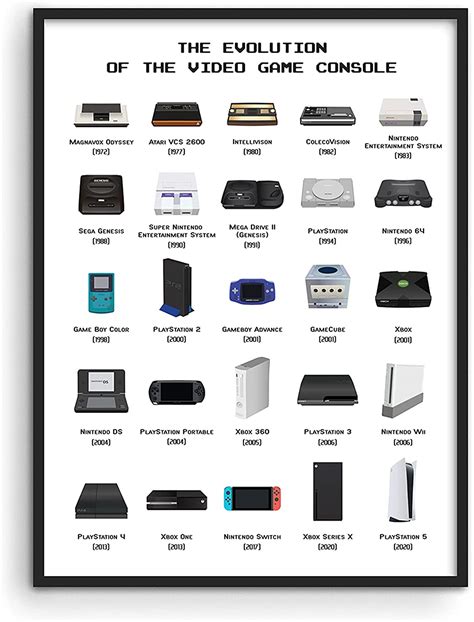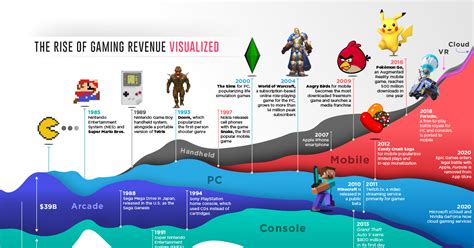5 Gaming Eras

The evolution of gaming has been a remarkable journey, spanning several decades and witnessing the birth of numerous iconic consoles, characters, and genres. The industry has undergone significant transformations, driven by advancements in technology, shifting consumer preferences, and the innovative spirit of game developers. To better understand this dynamic landscape, it's essential to break down the history of gaming into distinct eras, each characterized by its unique features, milestones, and contributions to the medium. In this article, we'll delve into the 5 gaming eras that have shaped the industry into what it is today.
Key Points
- The 5 gaming eras are defined by significant technological advancements and shifts in consumer behavior.
- Each era introduced new genres, gameplay mechanics, and iconic characters that influenced the industry's growth.
- The evolution of gaming has been marked by the rise of home consoles, the advent of 3D graphics, and the proliferation of online gaming.
- Handheld consoles, mobile gaming, and virtual reality (VR) have expanded the gaming landscape, offering new ways to play and interact with games.
- The current era is characterized by the dominance of online gaming, the growth of esports, and the increasing importance of game preservation and accessibility.
The Golden Age of Arcade Games (1970s-1980s)

This era saw the introduction of the first coin-operated arcade machines, which quickly gained popularity in amusement parks, malls, and dedicated arcades. Classics like Pong (1972), Space Invaders (1978), and Pac-Man (1980) defined the era, with their simple yet addictive gameplay, iconic characters, and competitive leaderboards. The Golden Age laid the groundwork for the gaming industry, establishing the concept of high scores, player engagement, and the importance of intuitive controls.
The Advent of Home Consoles
The introduction of home consoles like the Magnavox Odyssey (1972) and Atari 2600 (1977) marked a significant shift in the gaming landscape. These early consoles brought arcade experiences into living rooms, allowing players to enjoy their favorite games in the comfort of their own homes. Although the quality and variety of games were limited, the home console market paved the way for the development of more sophisticated hardware and software in the years to come.
| Console | Release Year | Notable Games |
|---|---|---|
| Atari 2600 | 1977 | Asteroids, Centipede, Missile Command |
| Intellivision | 1980 | Major League Baseball, Night Stalker, Pitfall! |
| ColecoVision | 1982 | Donkey Kong, Pepper II, Smurf |

The 8-Bit and 16-Bit Eras (1980s-1990s)

The introduction of 8-bit consoles like the Nintendo Entertainment System (NES) (1985) and Sega Master System (1986) revolutionized the gaming industry. These consoles offered improved graphics, sound, and gameplay, with iconic titles like Super Mario Bros. (1985), The Legend of Zelda (1986), and Sonic the Hedgehog (1991). The 16-bit era, led by consoles like the Sega Genesis (1989) and Super Nintendo Entertainment System (SNES) (1991), further pushed the boundaries of gaming with enhanced visuals, more complex gameplay, and the introduction of new genres like fighting games and RPGs.
The Rise of 3D Graphics
The transition to 3D graphics marked a significant milestone in the gaming industry. Consoles like the Sega Saturn (1994) and PlayStation (1994) introduced players to immersive, three-dimensional worlds, with games like Virtua Fighter (1993), Tomb Raider (1996), and Final Fantasy VII (1997). This era also saw the emergence of PC gaming as a major force, with the development of 3D graphics cards and the introduction of popular franchises like Quake (1996) and Half-Life (1998).
The Modern Era (2000s-2010s)
The modern era of gaming was characterized by the widespread adoption of online gaming, the rise of multiplayer experiences, and the growth of the gaming industry as a whole. Consoles like the PlayStation 2 (2000), Xbox (2001), and Nintendo Wii (2006) introduced innovative features like motion controls, online multiplayer, and digital distribution platforms. This era also saw the emergence of indie games, the proliferation of mobile gaming, and the growing importance of game preservation and accessibility.
The Impact of Virtual Reality (VR) and Augmented Reality (AR)
The introduction of VR and AR technologies has expanded the gaming landscape, offering new ways to play and interact with games. Consoles like the PlayStation VR (2016) and Oculus Rift (2016) have enabled players to immerse themselves in virtual worlds, while AR experiences like Pokémon Go (2016) have brought gaming into the real world. As VR and AR technologies continue to evolve, they are likely to play an increasingly important role in shaping the future of the gaming industry.
| Technology | Release Year | Notable Games |
|---|---|---|
| PlayStation VR | 2016 | Beat Saber, Job Simulator, Superhot VR |
| Oculus Rift | 2016 | Robo Recall, The Climb, Edge of Nowhere |
| Pokémon Go | 2016 | - |
The Current Era (2020s-present)
The current era of gaming is marked by the dominance of online gaming, the growth of esports, and the increasing importance of game preservation and accessibility. Consoles like the PlayStation 5 (2020) and Xbox Series X (2020) have introduced advanced features like ray tracing, artificial intelligence, and cloud gaming, while the rise of cloud gaming services like Google Stadia (2019) and Microsoft xCloud (2020) has enabled players to access high-quality games on a variety of devices. As the gaming industry continues to evolve, it’s likely that we’ll see further innovations in areas like VR, AR, and artificial intelligence, as well as a greater emphasis on game preservation, accessibility, and community engagement.
What are the key characteristics of the current era of gaming?
+The current era of gaming is marked by the dominance of online gaming, the growth of esports, and the increasing importance of game preservation and accessibility. It's also characterized by the introduction of advanced technologies like ray tracing, artificial intelligence, and cloud gaming.
How has the gaming industry evolved over the years?
+The gaming industry has undergone significant transformations, driven by advancements in technology, shifting consumer preferences, and the innovative spirit of game developers. It has evolved from the early days of arcade games to the current era of online gaming, esports, and game preservation.
What role do VR and AR technologies play in the gaming industry?
+VR and AR technologies have expanded the gaming landscape, offering new ways to play and interact with games. They have enabled players to immerse themselves in virtual worlds and brought gaming into the real world. As these technologies continue to evolve, they are likely to play an increasingly important role in shaping the future of the gaming industry.
In conclusion, the 5 gaming eras have each contributed significantly to the evolution of the industry, introducing new technologies, genres, and gameplay mechanics that have captivated audiences and driven innovation. As the gaming industry continues to grow and evolve, it’s essential to understand its rich history, recognize the key milestones and developments that have shaped it, and anticipate the exciting advancements that the future may hold.